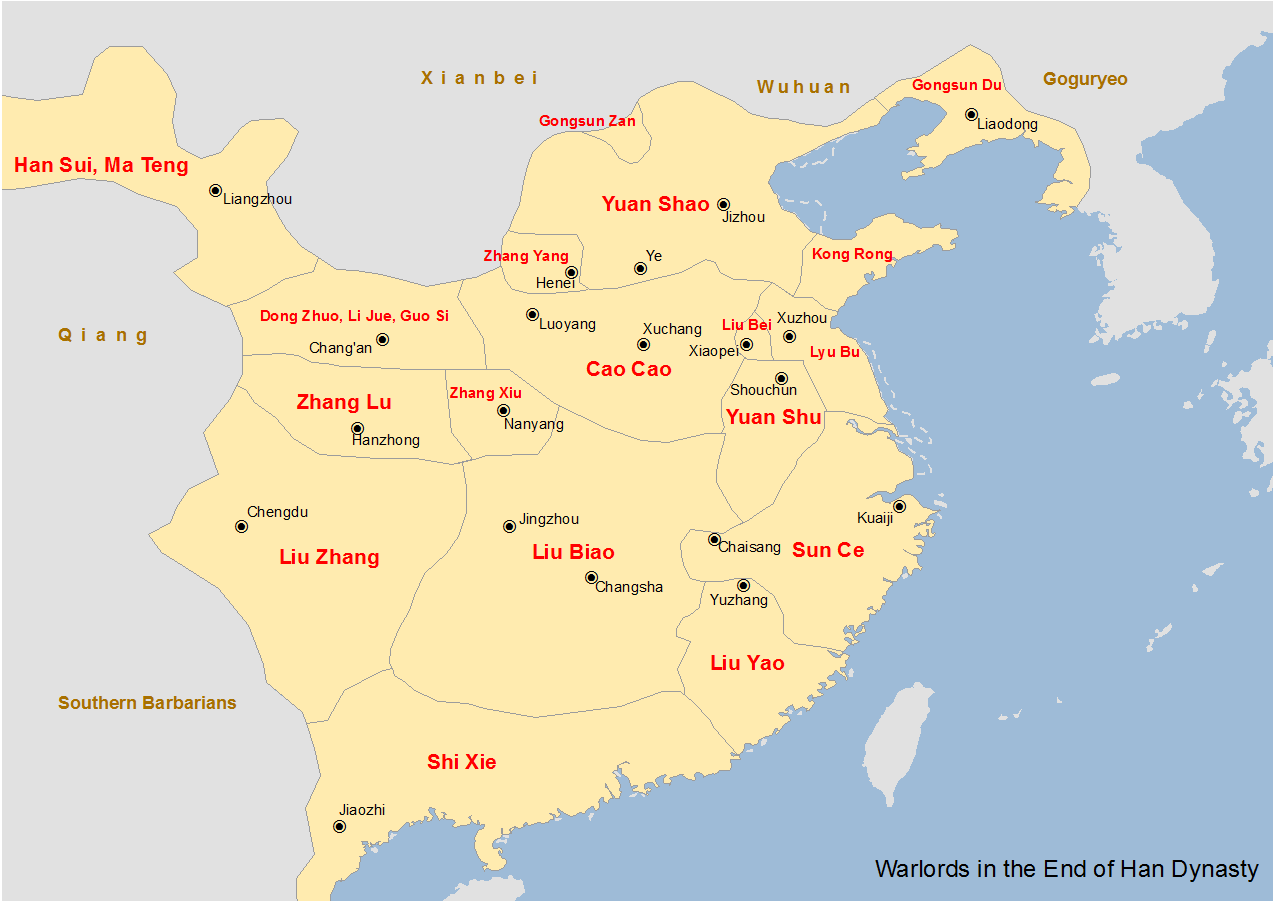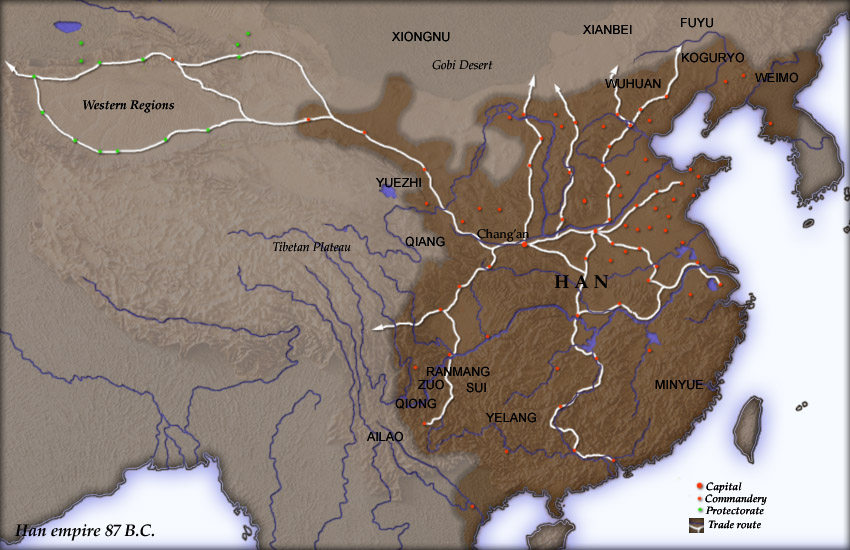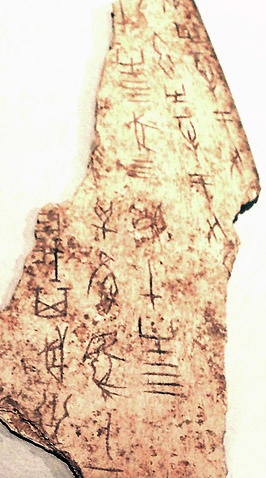|
Zhang Xiu (warlord)
Zhang Xiu (died 207) was a military general and minor warlord who lived during the late Eastern Han dynasty of China. In 197, he clashed with the warlord Cao Cao, who was then the ''de facto'' head of the Han central government, at the Battle of Wancheng and subsequent skirmishes. However, in 200, he heeded the suggestion from his adviser Jia Xu and surrendered to Cao Cao, who accepted his surrender and appointed him as a general. Having fought on Cao Cao's side at the decisive Battle of Guandu against a rival warlord Yuan Shao and in the subsequent campaigns against Yuan Shao's heirs, Zhang Xiu made great contributions during his service under Cao Cao. In 207, he died en route to joining Cao Cao on a campaign against the Wuhuan tribes. The Han imperial court honoured with the posthumous title "Marquis Ding". Life Zhang Xiu was from Zuli County (), Wuwei Commandery (), which is in present-day Jingyuan County, Gansu. He was a distant nephew of Zhang Ji, who served under the ... [...More Info...] [...Related Items...] OR: [Wikipedia] [Google] [Baidu] |
Qing Dynasty
The Qing dynasty ( ), officially the Great Qing, was a Manchu-led Dynasties of China, imperial dynasty of China and an early modern empire in East Asia. The last imperial dynasty in Chinese history, the Qing dynasty was preceded by the Ming dynasty and succeeded by the Republic of China (1912–1949), Republic of China. At its height of power, the empire stretched from the Sea of Japan in the east to the Pamir Mountains in the west, and from the Mongolian Plateau in the north to the South China Sea in the south. Originally emerging from the Later Jin (1616–1636), Later Jin dynasty founded in 1616 and proclaimed in Shenyang in 1636, the dynasty seized control of the Ming capital Beijing and North China in 1644, traditionally considered the start of the dynasty's rule. The dynasty lasted until the Xinhai Revolution of October 1911 led to the abdication of the last emperor in February 1912. The multi-ethnic Qing dynasty Legacy of the Qing dynasty, assembled the territoria ... [...More Info...] [...Related Items...] OR: [Wikipedia] [Google] [Baidu] |
Wuhuan
The Wuhuan (, < Eastern Han Chinese: *''ʔɑ-ɣuɑn'', < (c. 78 BCE): *''ʔâ-wân'' < *''Awar'') were a Proto-MongolicPulleyblank, Edwin G. (1983). "The Chinese and Their Neighbors in Prehistoric and Early Historic China," in The Origins of Chinese Civilization, University of California Press p. 452 of pp. 411–466. or |
Lists Of People Of The Three Kingdoms
The following are lists of people significant to the Three Kingdoms period (220–280) of Chinese history. Their names in Mandarin pinyin are sorted in alphabetical order. Fictional characters in the 14th-century historical novel '' Romance of the Three Kingdoms'' and those found in other cultural references to the Three Kingdoms are listed separately in List of fictional people of the Three Kingdoms. Lists * List of people of the Three Kingdoms (A) * List of people of the Three Kingdoms (B) * List of people of the Three Kingdoms (C) * List of people of the Three Kingdoms (D) * List of people of the Three Kingdoms (E) * List of people of the Three Kingdoms (F) * List of people of the Three Kingdoms (G) * List of people of the Three Kingdoms (H) * List of people of the Three Kingdoms (I) * List of people of the Three Kingdoms (J) * List of people of the Three Kingdoms (K) * List of people of the Three Kingdoms (L) * List of people of the Three Kingdoms (M) * Li ... [...More Info...] [...Related Items...] OR: [Wikipedia] [Google] [Baidu] |
Qiang (historical People)
Qiang () was a name given to various groups of people at different periods in ancient China. The Qiang people are generally thought to have been of Tibeto-Burman languages, Tibeto-Burman origin, though there are other theories. The Tangut people of the Tang dynasty, Tang, Song dynasty, Song and Yuan dynasty, Yuan dynasties may be of Qiang descent. The modern Qiang people as well as Tibetan people, Tibetans may also have been descended in part from the ancient Qiang. Etymology According to the Han dynasty dictionary ''Shuowen Jiezi'', the Qiang were shepherds, and the Chinese character for Qiang () was thus formed from the characters for "sheep" (羊) and "man" (人), and pronounced like the word for "sheep".Shouwen Original text: 羌:西戎牧羊人也。从人从羊,羊亦聲。 ''Fengsu Tongyi'' also mentions that character of Qiang ... [...More Info...] [...Related Items...] OR: [Wikipedia] [Google] [Baidu] |
Cao Anmin
The war between Cao Cao and Zhang Xiu was fought between the warlords Cao Cao and Zhang Xiu between 197 and 199 in the late Eastern Han dynasty of China. It concluded with Zhang Xiu's surrender to Cao Cao. Background In 196, the warlord Cao Cao led his forces into the ruins of the old imperial capital, Luoyang, where he met Emperor Xian, the figurehead Han emperor who had been held hostage consecutively by the warlords Dong Zhuo, Li Jue and Guo Si since his coronation in 189. He had only escaped from Chang'an in late 195 after being held hostage by Li Jue and Guo Si since Dong Zhuo's death in 192. Cao Cao treated the emperor respectfully and escorted him from Luoyang to his own base in Xu (許; present-day Xuchang, Henan), which became the new imperial capital. In the meantime, Li Jue and Guo Si's power bloc in Chang'an and the Guanzhong region started to weaken and break up – especially after Emperor Xian's escape. Zhang Ji (Han dynasty), Zhang Ji, a former ally of Li Ju ... [...More Info...] [...Related Items...] OR: [Wikipedia] [Google] [Baidu] |
Cao Ang
Cao Ang () ( 177 – February or March 197), courtesy name Zixiu, was the eldest son of Cao Cao, a warlord who rose to power towards the end of the Han dynasty and laid the foundation of the state of Cao Wei in the Three Kingdoms period of China. He was killed at the Battle of Wancheng in 197. Life Cao Ang was the first son of Cao Cao and his concubine Lady Liu (劉夫人). Lady Liu also bore Cao Cao another son, Cao Shuo (曹鑠), and a daughter, Grand Princess Qinghe (清河長公主). However, as Lady Liu died early, Cao Ang was raised by Cao Cao's first official spouse, Lady Ding (丁夫人), who treated Cao Ang as though he was her own son. Nothing was recorded in history about Cao Ang's early life, except that he was nominated as a '' xiaolian'' (civil service candidate) when he reached the age of adulthood (around 19 years old). In February or March 197, Cao Ang followed his father on a campaign against the warlord Zhang Xiu in Wan (宛; or Wancheng, in present-day W ... [...More Info...] [...Related Items...] OR: [Wikipedia] [Google] [Baidu] |
Dian Wei
Dian Wei (; died February or March 197) was a military general serving under the warlord Cao Cao in the late Eastern Han dynasty of China. Famed for his enormous strength, Dian Wei excelled at wielding a pair of '' ji''s (a halberd-like weapon), each of which was said to weigh 40 '' jin''. He was killed in action at the Battle of Wancheng while covering Cao Cao's escape from Zhang Xiu's forces. Background Dian Wei was from Jiwu County (), Chenliu Commandery (), in present-day Ningling County, Henan. He was described as a stalwart man with great strength and the ambition of becoming a '' youxia'' (vigilante). Assassinating Li Yong When he was young, Dian Wei once agreed to help a certain Liu family in Xiangyi County (襄邑縣; present-day Sui County, Henan) take revenge against one Li Yong (). As Li Yong was a former county chief, he had bodyguards to protect him during his travels.(襄邑劉氏與睢陽李永為讎,韋為報之。永故富春長,備衞甚謹。) ''Sangu ... [...More Info...] [...Related Items...] OR: [Wikipedia] [Google] [Baidu] |
Jing Province
Jingzhou or Jing Province was one of the Nine Provinces of ancient China referenced in early Chinese texts such as the ''Yu Gong, Tribute of Yu'', ''Erya'', and ''Rites of Zhou''. Jingzhou became an administrative division during the reign of Emperor Wu of Han, Emperor Wu (r. 141–87 BCE) in the Western Han dynasty (206 BCE–9 CE). It usually corresponded with the modern-day provinces of Hubei and Hunan until the Sui dynasty, after which it referred to the city of Jingzhou. History Pre-Qin era In the Warring States period, the Chu (state), Chu state covered most of present-day Hubei and Hunan, the areas that would form Jingzhou in a later era. The Qin (state), Qin state dropped the name "Chu" (楚) (literally "chaste tree") and used its synonym "Jing" (荊) instead to avoid a naming taboo, since the personal name of Qin's King Zhuangxiang of Qin, King Zhuangxiang (281–247 BCE) was "Zichu" (子楚; lit. "son of Chu") because his adoptive mother, Lady Huayang, was fro ... [...More Info...] [...Related Items...] OR: [Wikipedia] [Google] [Baidu] |
Liu Biao
Liu Biao () () ( 151 – September 208), courtesy name Jingsheng, was a Chinese military general, politician, and warlord who lived in the late Eastern Han dynasty of China. He is best known for serving as the governor of Jing Province (covering present-day Hubei and Hunan) from 192 until his death in 208. He was also a member of the extended family of the Han emperors through his ancestor Liu Yu, the fifth son of Emperor Jing. Liu Biao was described as a handsome man and was over eight '' chi'' tall (1.86 metres). Life In 166 to 167, when Liu Biao was 17 (by East Asian reckoning), he became a student of Wang Chang (grandfather of Wang Can). At the time, Wang Chang was Administrator of Nanyang (南阳太守). Liu Biao gained control of Jing Province (covering present-day Hubei and Hunan) in 190 CE, when Dong Zhuo appointed him to the position after the death of its previous governor (or inspector), Wang Rui. Liu Biao later started a war against the warlord Yuan Shu and his ... [...More Info...] [...Related Items...] OR: [Wikipedia] [Google] [Baidu] |
Henan
Henan; alternatively Honan is a province in Central China. Henan is home to many heritage sites, including Yinxu, the ruins of the final capital of the Shang dynasty () and the Shaolin Temple. Four of the historical capitals of China, Luoyang, Anyang, Kaifeng and Zhengzhou, are in Henan. While the province's name means 'south of the river', approximately a quarter of the province lies north of the Yellow River. With an area of , Henan covers a large part of the fertile and densely populated North China Plain. Its neighboring provinces are Shaanxi, Shanxi, Hebei, Shandong, Anhui, and Hubei. Henan is China's third-most populous province and the most populous among inland provinces, with a population of over 99 million as of 2020. It is also the world's seventh-most populous administrative division; if it were a country by itself, Henan would be the 17th-most populous in the world, behind Egypt and Vietnam. People from Henan often suffer from regional discrimination ... [...More Info...] [...Related Items...] OR: [Wikipedia] [Google] [Baidu] |
Nanyang, Henan
Nanyang is a prefecture-level city in the southwest of Henan province, China. The city with the largest administrative area in Henan, Nanyang borders Xinyang to the southeast, Zhumadian to the east, Pingdingshan to the northeast, Luoyang to the north, Sanmenxia to the northwest, the province of Shaanxi to the west, and the province of Hubei to the south. Nanyang is known for its outstanding people and land, producing numerous talents. In history, it nurtured the "sage of science" Zhang Heng, "sage of medicine" Zhang Zhongjing, "sage of commerce" Fan Li, and "sage of intelligence" Zhuge Liang. It also nurtured contemporary celebrities such as philosopher Feng Youlan, military strategist Peng Xuefeng, novelist Yao Xueyin, inventor Wang Yongmin, and writer Er Yuehe. Names In the name "Nanyang" ( zh, s= , t= , p=Nányáng), ''Nan'' () means south, and ''Yang'' (/) means sun—the south side of a mountain, or the north side of a river, in Chinese language, Chinese is called ''Ya ... [...More Info...] [...Related Items...] OR: [Wikipedia] [Google] [Baidu] |
Chang'an
Chang'an (; zh, t=長安, s=长安, p=Cháng'ān, first=t) is the traditional name of the city now named Xi'an and was the capital of several Chinese dynasties, ranging from 202 BCE to 907 CE. The site has been inhabited since Neolithic times, during which the Yangshao culture was established in Banpo, in what is now the city's suburbs. Furthermore, in the northern vicinity of modern Xi'an, Qin Shi Huang of the Qin dynasty, China's first emperor, held his imperial court and constructed his massive mausoleum guarded by the Terracotta Army. From its capital at Xianyang, the Qin dynasty ruled a larger area than either of the preceding dynasties. The imperial city of Chang'an during the Han dynasty was located northwest of today's Xi'an. During the Tang dynasty, the area that came to be known as Chang'an included the area inside the Ming Xi'an fortification, plus some small areas to its east and west, and a substantial part of its southern suburbs. Thus, Tang Chang'an was eight t ... [...More Info...] [...Related Items...] OR: [Wikipedia] [Google] [Baidu] |






